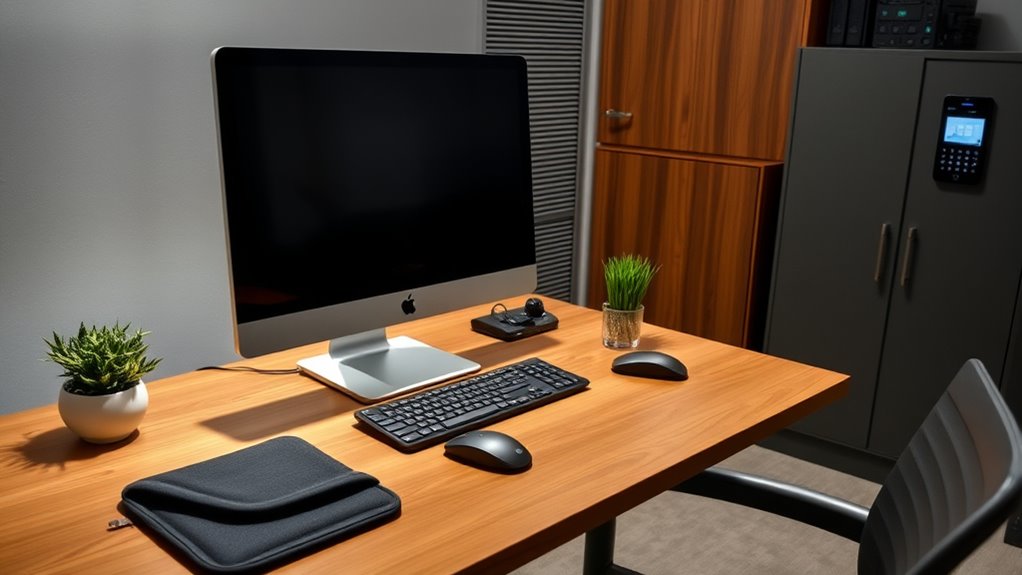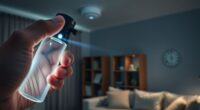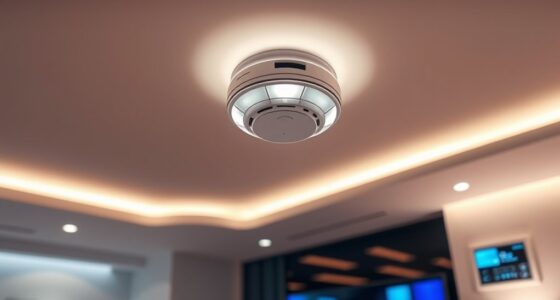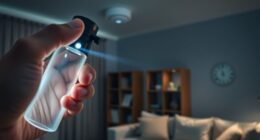To safeguard your work equipment and data at home, make certain your workspace has ergonomic furniture that promotes good posture and reduces risk of injury. Use surge protectors and avoid overloading outlets to prevent electrical fires, while organizing cords with clips to avoid tripping hazards. Keep liquids away from electronics and maintain organized wiring. By following proper electrical safety tips, you’ll create a secure environment. Keep exploring for more tips to keep your home office safe and efficient.
Key Takeaways
- Use surge protectors to safeguard equipment against power surges and voltage fluctuations.
- Keep electrical cords organized and away from liquids to prevent damage and data loss.
- Position devices near grounded outlets to reduce electrical shock risks and protect data integrity.
- Regularly inspect and replace damaged cords or plugs to prevent electrical failures.
- Maintain a clutter-free workspace to minimize tripping hazards and accidental equipment damage.

Setting up your home office safely is vital to prevent injuries and guarantee productivity. When creating your workspace, paying close attention to ergonomic furniture and electrical safety helps protect your health and your equipment. Ergonomic furniture is key to maintaining good posture and reducing strain during long work hours. Choose a desk that fits your height and allows your feet to rest flat on the floor. An adjustable chair with lumbar support keeps your back supported and encourages proper alignment. Position your monitor at eye level to avoid neck strain, and use a keyboard and mouse that promote a natural hand position. These adjustments can greatly decrease the risk of musculoskeletal issues and help you stay comfortable throughout the day.
Electrical safety is equally paramount when setting up your home office. Start by ensuring all your devices are plugged into surge protectors, which guard your equipment against power surges and outages. Avoid overloading outlets; too many devices connected to a single socket can cause overheating and increase the risk of electrical fires. Keep cords organized and out of walkways to prevent tripping hazards. Use cable organizers or clips to manage excess wiring, and avoid running cords under rugs or furniture, as this can cause overheating or damage. Regularly inspect cords and plugs for signs of wear or damage, and replace any frayed or broken items immediately. Additionally, make sure your power strips have built-in safety features, such as circuit breakers, to protect your devices.
Position your workspace near a grounded outlet to minimize the risk of electrical shock. Be cautious when using extension cords—only use them temporarily and ensure they’re rated for the power load of your devices. Keep liquids away from electrical outlets and cords to prevent spills that could cause short circuits or fires. If you notice any flickering lights or unusual electrical behavior, don’t ignore it; consult an electrician to address potential wiring issues. Proper electrical safety not only protects your equipment but also keeps you safe from potential hazards associated with faulty wiring or overloaded circuits. Incorporating electrical safety measures can further reduce risks and ensure a secure working environment.
Frequently Asked Questions
How Can I Prevent Theft of My Work Equipment at Home?
To prevent theft of your work equipment at home, you should enhance your home security by installing cameras, locks, and motion detectors. Keep your devices in a secure, hidden spot when not in use. Consider equipment insurance for added protection. Also, avoid sharing your workspace details publicly and always lock doors and windows to minimize theft risks. These steps help safeguard your work tools effectively.
What Are the Best Practices for Securing Sensitive Work Data?
To secure sensitive work data, you should use data encryption to protect information both at rest and in transit. Implement strict access controls, such as strong passwords and multi-factor authentication, to limit who can access your data. Regularly update your software to patch vulnerabilities and keep your security measures current. By combining encryption and access controls, you guarantee that only authorized individuals can view or modify your sensitive information.
How Do I Ensure Fire Safety With Electronic Devices?
Imagine your home office as a safe haven, where fire alarm systems stand vigilant like watchful guardians. To guarantee fire safety with electronic devices, regularly check that your smoke detectors are functioning and keep fire extinguishers nearby. Practice electrical safety by avoiding overloading outlets and inspecting cords for damage. These steps help protect your workspace, preventing fires and safeguarding your equipment and data from potential harm.
What Should I Do if I Suspect a Cybersecurity Breach?
If you suspect a cybersecurity breach, act quickly by initiating your breach response plan. Disconnect your device from the internet to prevent further access, and alert your IT department immediately. Change all relevant passwords and monitor your accounts for suspicious activity. Document everything related to the cybersecurity incident to aid later investigations. Taking prompt action helps contain the breach and minimizes potential damage.
How Can I Protect My Home Wi-Fi Network From Unauthorized Access?
To protect your home Wi-Fi network from unauthorized access, start by enabling Wi-Fi encryption like WPA3 or WPA2, which secures your data. Next, set a strong, unique password and update your router’s firmware regularly. You should also use network segmentation by creating separate networks for work and personal devices, reducing risks. These steps help keep your data safe and prevent unauthorized users from accessing your network.
Conclusion
By prioritizing safety and organization, you can protect your work equipment and data effectively. For instance, imagine someone who neglected cable management, only to have a fire hazard caused by overheating. On the other hand, by keeping cables tidy and securing devices, you prevent accidents and data breaches. Remember, a safe home office isn’t just about comfort—it’s about safeguarding your work and peace of mind every day.









